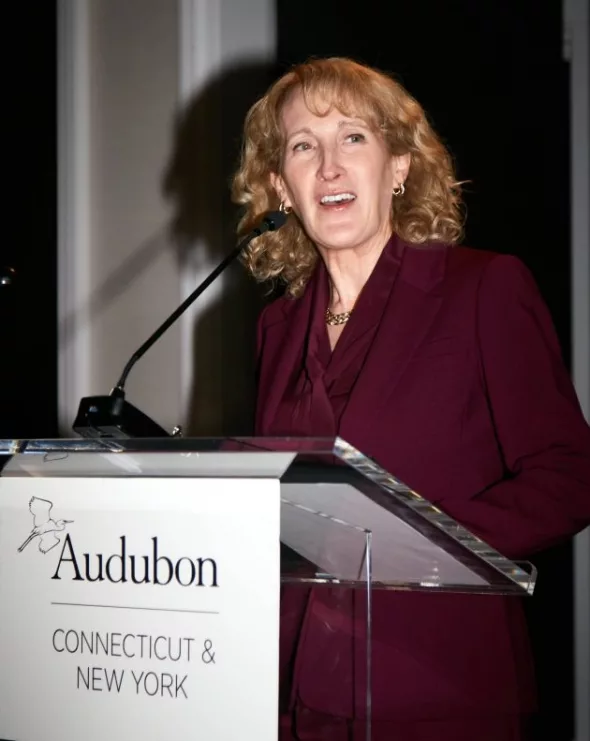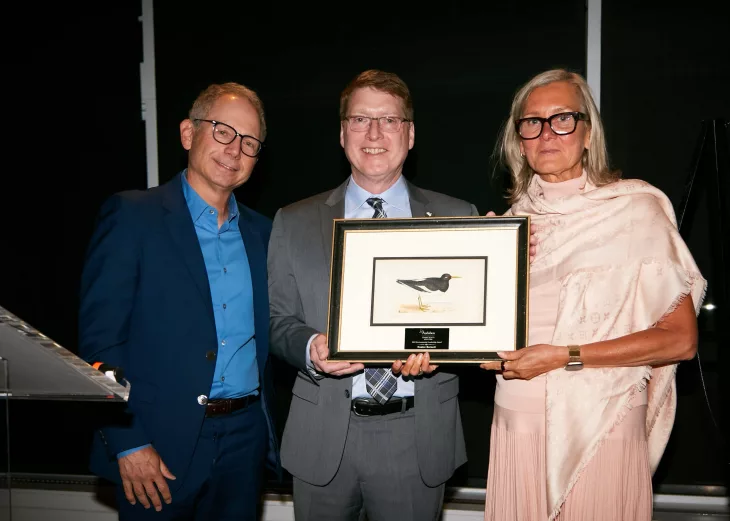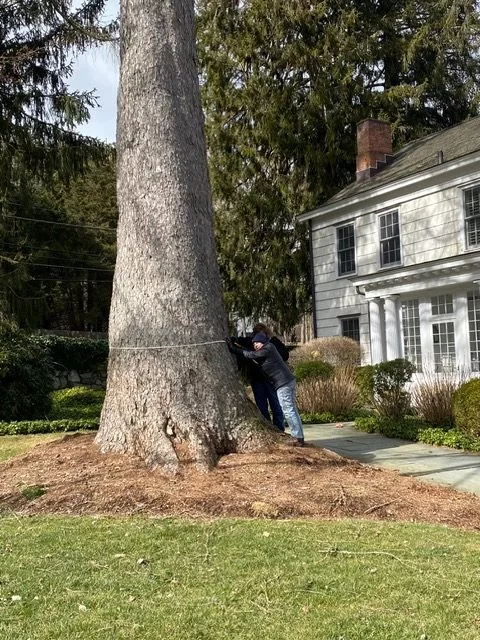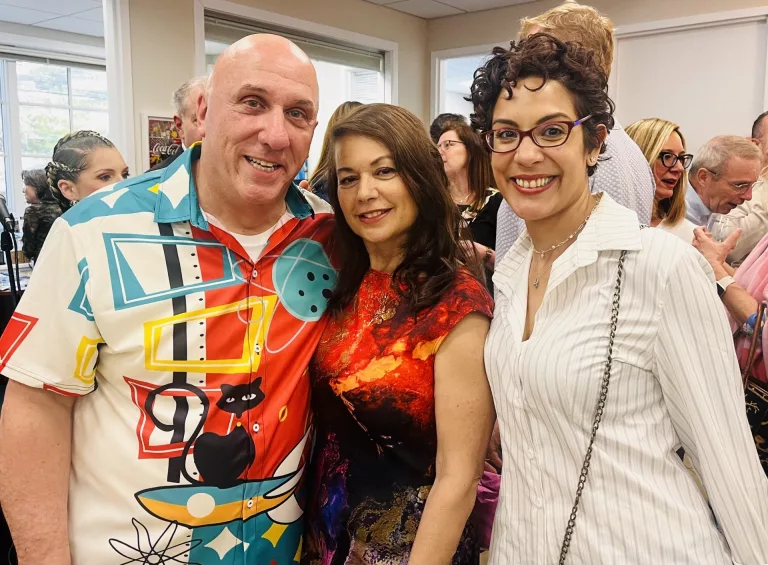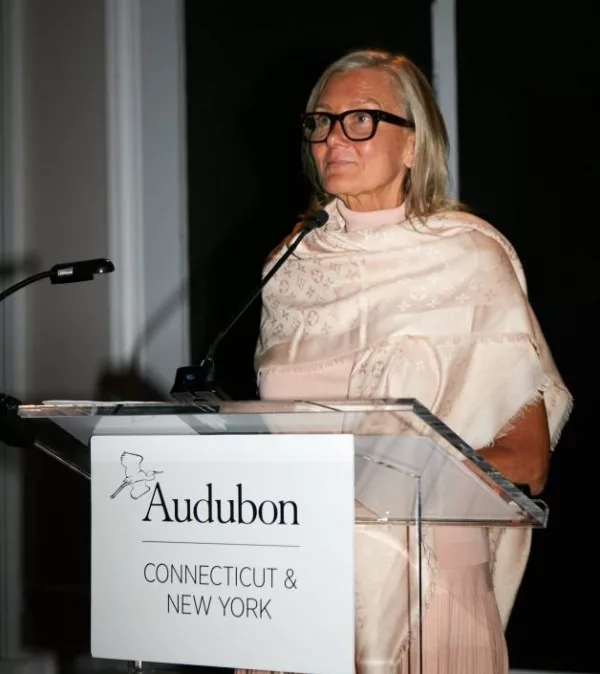
By Anne W. Semmes
At sunset a week ago Thursday, overlooking the green rolling hills of the Tamarack Country Club stretching across 180 acres of backcountry Greenwich, the 235 nature enthusiasts gathered for the 2025 Audubon Connecticut Environmental Leadership Awards Benefit. Being honored was Awardee Eunice Burnett of Greenwich for her impactful work in conservation and environmental community building.
But before Burnett’s notable acceptance talk were remarks by Dr. Elizabeth Gray, CEO of the National Audubon Society, and introduced as the first female to hold that office since Audubon’s founding in 1905. Gray had just arrived from Washington attending the U.S. Climate Action Summit Leaders Forum. “It’s a true pleasure,” she began, “to be here tonight in a room full of people who have the same passion that I do for birds and for nature and for the future that we’re all building together.”
Gray thanked Greenwich Audubon board chair Kim Gregory “for bringing together this community in honor of Eunice Burnett and her remarkable contributions.” More thanks went to Gregory and to Mike Burger, vice president and executive director of Audubon Connecticut and New York “for growing the Audubon flock.” Gray cited the “action in Greenwich at the Audubon Center. We’re restoring 22 acres of early successional habitat and we’re doing that by planting pollinator gardens, by revitalizing trails and by expanding forest edges that are supporting really important bird and pollinator habitat.”
“At the heart of this effort,” Gray noted, “is our guiding star: bending the bird curve – halting and ultimately reversing the decline of birds across the Americas. Because birds are more than beautiful. They are symbols of our connection to the natural world, and sentinels of its health.” Thus “When birds are doing well, the planet’s thriving and when birds are in decline, we’ve got some serious challenges to tackle and work to do. So, that’s why the work that we do not only protects birds, it strengthens communities such as this one that’s in the room tonight. It helps us all build resilience and it improves the quality of habitat, not just for birds, but also for people.”
Awardee Eunice Burnett
Awardee Eunice Burnett was introduced by Burger as “epitomizing community building and action.” “When Eunice sees something that needs to be done, she steps up and does it…Just recently she had an idea to prepare and deliver bird-centric welcome boxes to families who are new to the area to welcome them to Greenwich and introduce them to the Greenwich Audubon Center. What a great idea.”
Burnett, who serves on the board of Audubon Connecticut/ Audubon New York, began with humility, “I’m just an average person who has a deep appreciation for nature and maybe that’s why I’m a good person to talk to all of you tonight.” Her formative influences followed.
She began her work in her twenties as an equity research analyst. “As I researched the chemical industry,” she told, “I became aware of what some companies like Monsanto were doing to our environment in food supply…When I had children, everything took on new intensity. Mercury in tuna fish, pesticides in fruits and vegetables, nitrates in hot dogs, trans fats in everything…I stopped feeding my Kentucky group blue grass sod nitrogen fertilizer to prevent algae growth in our local freshwater ponds. Our landscapers were not happy…I was rewarded with the sighting of a beautiful Luna moth on my lawn. I swear its green wings flapped me a little thank you for its natural playground.”
Taking her three kids skiing where she had skied in her youth on “the highest mountain” of Germany, she shared, “When we finally arrived, we did not see a giant snow-capped mountain. Instead, we saw a bare granite rock. The ski resort was now a ghost town. The tiniest dirtiest patch of snow was the only remnant of the once magnificent glacier. Amid my shock and horror, I had an epiphany. I had put these three people on the planet. I owed it to them to make sure that the planet was still functioning when they were my age.”
Joining the environmental network
Burnett then “sought out like-minded people who supported environmental organizations with their time, talent, and treasure.” She was inspired to do the same. “I chair Green Our Children to benefit research at Mount Sinai’s Children Environmental Health Center. I chair the environmental education committee at the Junior League where it’s monitored by Susie Baker…who has received Audubon’s Environmental Lifetime Achievement Award and is an overall total force in conservation. She’s here tonight. Thank you, Susie.”
Burnett “became part of a great environmental committee at Stanwich School.” She joined GRAB – the Greenwich Recycling Advisory Board. She worked with the Environmental Task Force and Greening of Greenwich, “both town initiatives headed by Lin Lavery, who at the time was Second Selectwoman. Shout out to Lin.”
Burnett then became a board member of Audubon Connecticut. “That was 16 years ago. I joined the board to help our state start its Audubon and Home Initiative, which many of you know today as Bird Friendly Communities. Its goal is to teach people the best practices to develop their properties into healthy habitats for humans, birds, and other wildlife.”
Over the years Audubon had taught her, “how to be a better steward of the natural world through the interconnectedness of the ecosystem. Conservation with a bird focus has a positive, broader impact on all wildlife, including humans.” To spotlight that interconnectedness, she quoted Thoreau. “All parts of nature belong to one head as curls of a maiden’s hair.”
For nearly seven years, she has served on the board of The Nature Conservancy (TNC) or TNC. “TNC and Audubon often collaborate to achieve important conservation objectives. After decades of a more siloed approach, environmental organizations are now taking a page from nature’s playbook. They have begun to work together, mirroring the ecological interconnectedness that exists in nature. They have realized that they belong to one head as the curls of a maiden’s hair.”
The power of native plants
Burden has also “become fascinated by native plants and their importance to the wellbeing of our pollinators and birds. Native plants are weapons that we can use to combat the dual existential crises of biodiversity loss and climate change.” To learn more of “how that works,” she invited attendees to come to a “Pollinator Potluck” program in May at Round Hill Community Church.
This spring, she suggested, “Think about planting a native plant to feed our birds and pollinators – an Oak tree, Service berry, American Holly, Chokeberry or Spicebush…And come winter, “put up a bird feeder and experience the joy of watching and hearing titmice, nuthatches, black capped chickadees, downy and hairy woodpeckers…” And download Cornell Ornithology’s bird app Merlin on your phone. “The program will help you identify birds you hear when out and about – or don’t. Instead, just sit outside, watch and listen.”
She concluded with her hope, “We can all agree that these bird songs are beautiful and moving and their absence would be tragic. We may not agree on everything, but diversity of ideas and solutions AND biodiversity are critical to our survival – humans as well as birds.” But “Let us agree that birds are worth saving for our future generations.”
Burnett would leave us with another Thoreau quote: “As I love nature, as I love singing birds…I love thee, my friend.” “Thank you all for coming.”
